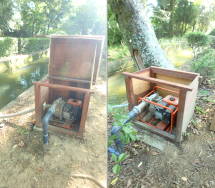
|
岡大構内を流れる座主川遊歩道脇には撒水用の取水施設が何カ所か設置されている。8月18日朝はフタが開けられ、東西通りのツツジ類への撒水のためポンプがフル稼動している様子を眺めることができた。 |
じぶん更新日記1997年5月6日開設Copyright(C)長谷川芳典 |

|
岡大構内を流れる座主川遊歩道脇には撒水用の取水施設が何カ所か設置されている。8月18日朝はフタが開けられ、東西通りのツツジ類への撒水のためポンプがフル稼動している様子を眺めることができた。 |
【思ったこと】 160817(水)トールネケ『関係フレーム理論(RFT)をまなぶ』(94)アナロジー、メタファー、そして自己の体験(30)「般化オペラント」についての復習(13)「関係づける」の意味(6) 8月17日の続き。 Hayes, S. C., Barnes-Holmes, D., & Roche, B. (Eds.). (2001). Relational Frame Theory: A Post-Skinnerian account of human language and cognition. New York: Plenum Press の27頁には、関係フレームを含めた「反応フレーム(response frame)」の有用性が論じられている。 The concept of a response frame is useful when the response at issue includes contextual control over an overarching operant that includes specific assigned forms. Skinner's concept of an autoclitic frame, described in the previous chapter, is an example (e.g., "when you hear _____ you will receive a _____"). Imagine that a person hears a variety of sentences, such as "when you hear a knock you will receive a package" and "when you hear the recess bell you will receive a break." Eventually any term can be placed into this "autoclitic frame" and the listener may know what to expect. Just as a picture frame can hold many pictures, a response frame can include different formal features while still being a definable instance of an overall pattern. "Frame" is not a new technical term, and it is not a structure, mental entity, or brain process. It is a metaphor that refers to a characteristic feature of some purely functional response classes: the behavioral class provides an overall functional pattern, but the current context provides the specific formal features that occur in specified parts of that pattern.関係フレームについては、この連載の対象であるトールネケの本を含めて他の入門書でもほぼ同じように紹介されているが、もともとはこのRFTの本、もしくはそれに先行して発表された関連論文の記述に依拠しているように思われる。後半のところに記されているように、「"Frame" is not a new technical term, and it is not a structure, mental entity, or brain process. (「フレーム」は新しい専門用語ではないし、何かの構造でもないし、精神的実在でも脳内プロセスでもない」。「フレーム」というのは一種のメタファーであり、(物理的特性の類似性・共通性に依拠しない)純粋に機能的に定義された反応クラスの特徴を言い表したものであるとされている。 次回に続く。 |